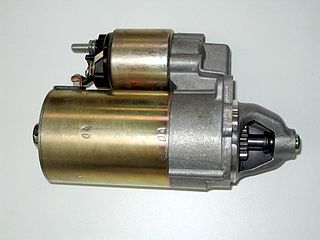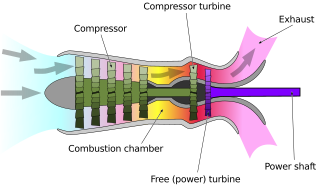Related Research Articles

A turbocharger, colloquially known as a turbo, is a turbine-driven, forced induction device that increases an internal combustion engine's efficiency and power output by forcing extra compressed air into the combustion chamber. This improvement over a naturally aspirated engine's power output is because the compressor can force more air—and proportionately more fuel—into the combustion chamber than atmospheric pressure alone.

A gas turbine, also called a combustion turbine, is a type of continuous and internal combustion engine. The main elements common to all gas turbine engines are:

An auxiliary power unit (APU) is a device on a vehicle that provides energy for functions other than propulsion. They are commonly found on large aircraft and naval ships as well as some large land vehicles. Aircraft APUs generally produce 115 V alternating current (AC) at 400 Hz, to run the electrical systems of the aircraft; others can produce 28 V direct current (DC). APUs can provide power through single- or three-phase systems.

A starter is a device used to rotate (crank) an internal-combustion engine so as to initiate the engine's operation under its own power. Starters can be electric, pneumatic, or hydraulic. In the case of very large engines, the starter can even be another internal-combustion engine.

The Pratt & Whitney Canada PT6 is a turboprop aircraft engine produced by Pratt & Whitney Canada. Its design was started in 1958, it first ran in February 1960, first flew on 30 May 1961, entered service in 1964 and has been continuously updated since. It consists of two basic sections: a gas generator with accessory gearbox and a free power turbine with reduction gearbox, and is often seemingly mounted backwards in an aircraft in so far as the intake is at the rear and the exhaust at the front. Many variants of the PT6 have been produced, not only as turboprops but also for helicopters, land vehicles, hovercraft, boats, as auxiliary power units and for industrial uses. By November 2015, 51,000 had been produced, had logged 400 million flight hours from 1963 to 2016. It is known for its reliability with an in-flight shutdown rate of 1 per 651,126 hours in 2016. The PT6A covers the power range between 580 and 1,940 shp while the PT6B/C are turboshaft variants for helicopters.

A turboshaft engine is a form of gas turbine that is optimized to produce shaftpower rather than jet thrust. In concept, turboshaft engines are very similar to turbojets, with additional turbine expansion to extract heat energy from the exhaust and convert it into output shaft power. They are even more similar to turboprops, with only minor differences, and a single engine is often sold in both forms.

The J-2 was a liquid-fuel cryogenic rocket engine used on NASA's Saturn IB and Saturn V launch vehicles. Built in the U.S. by Rocketdyne, the J-2 burned cryogenic liquid hydrogen (LH2) and liquid oxygen (LOX) propellants, with each engine producing 1,033.1 kN (232,250 lbf) of thrust in vacuum. The engine's preliminary design dates back to recommendations of the 1959 Silverstein Committee. Rocketdyne won approval to develop the J-2 in June 1960 and the first flight, AS-201, occurred on 26 February 1966. The J-2 underwent several minor upgrades over its operational history to improve the engine's performance, with two major upgrade programs, the de Laval nozzle-type J-2S and aerospike-type J-2T, which were cancelled after the conclusion of the Apollo program.
Williams International is an American manufacturer of small gas turbine engines based in Pontiac, Michigan, United States. It produces jet engines for cruise missiles and small jet aircraft.
An air cycle machine (ACM) is the refrigeration unit of the environmental control system (ECS) used in pressurized gas turbine-powered aircraft. Normally an aircraft has two or three of these ACM. Each ACM and its components are often referred as an air conditioning pack. The air cycle cooling process uses air instead of a phase changing material such as Freon in the gas cycle. No condensation or evaporation of a refrigerant is involved, and the cooled air output from the process is used directly for cabin ventilation or for cooling electronic equipment.

A pneumatic motor, or compressed air engine, is a type of motor which does mechanical work by expanding compressed air. Pneumatic motors generally convert the compressed air energy to mechanical work through either linear or rotary motion. Linear motion can come from either a diaphragm or piston actuator, while rotary motion is supplied by either a vane type air motor, piston air motor, air turbine or gear type motor.

The Garrett TFE731 is a family of geared turbofan engines commonly used on business jet aircraft. Garrett AiResearch originally designed and built the engine, which due to mergers was later produced by AlliedSignal and now Honeywell Aerospace.

The General Electric GE38 is a gas turbine developed by GE Aviation for turboprop and turboshaft applications. It powers the Sikorsky CH-53K King Stallion as the T408.

The Wright Brothers Medal was conceived of in 1924 by the Dayton Section of the Society of Automotive Engineers, and the SAE established it in 1927 to recognize individuals who have made notable contributions in the engineering, design, development, or operation of air and space vehicles. The award is based on contributed research papers.

The Honeywell/ITEC F124 is a low-bypass turbofan engine derived from the civilian Honeywell TFE731. The F125 is an afterburning version of the engine. The engine began development in the late 1970s for the Republic of China (Taiwan) Air Force AIDC F-CK Indigenous Defence Fighter (IDF), and it first ran in 1979. The F124/F125 engine has since been proposed for use on other aircraft, such as the T-45 Goshawk and the SEPECAT Jaguar, and currently powers the Aero L-159 Alca and the Alenia Aermacchi M-346. The F124 has a rather unusual design for a two spool gas turbine engine, using both axial and centrifugal compressors in its high-pressure compressor. There are currently only three production variants of the engine, although several more have been proposed throughout its lifespan.
Honeywell Aerospace is a manufacturer of aircraft engines and avionics, as well as a producer of auxiliary power units (APUs) and other aviation products. Headquartered in Phoenix, Arizona, it is a division of the Honeywell International conglomerate. It generates approximately $10 billion in annual revenue from a 50/50 mix of commercial and defense contracts.
Garrett AiResearch was a manufacturer of turboprop engines and turbochargers, and a pioneer in numerous aerospace technologies. It was previously known as Aircraft Tool and Supply Company, Garrett Supply Company, AiResearch Manufacturing Company, or simply AiResearch. In 1964, Garrett AiResearch merged with Signal Oil & Gas to form a company renamed in 1968 to Signal Companies, which in 1985 merged with Allied Corp. into AlliedSignal. In 1999 AlliedSignal acquired Honeywell and adopted the Honeywell name.
The Pratt & Whitney GG4 and FT4 are related aero-derivative gas turbine engines developed from the Pratt & Whitney J75/JT4 turbojet line. They are axial twin spool turbojets with a can-annular type combustion element, typically operated as turboshaft engines. In this configuration the gas generator provides the expanding gases to drive a power or “Free Turbine”. This turbine is then used to drive electrical generators, mechanical pumps or propellers for marine applications.
Solar Turbines Incorporated, a wholly owned subsidiary of Caterpillar Inc., designs and manufactures industrial gas turbines for onshore and offshore electrical power generation, for marine propulsion and for producing, processing and transporting natural gas and oil.

Many variations of aircraft engine starting have been used since the Wright brothers made their first powered flight in 1903. The methods used have been designed for weight saving, simplicity of operation and reliability. Early piston engines were started by hand, with geared hand starting, electrical and cartridge-operated systems for larger engines being developed between the wars.

Homer J. Wood was an engineer at Garrett AiResearch, who did pioneering work in gas turbine engines for aircraft applications. He won the Wright Brothers Medal in 1949 with Frederick Dallenbach for a paper discussing auxiliary turbines to supply pneumatic power for aircraft based on the Garrett GTC43/44 and GTP70 units. Wood went on to design the GTC85, one of the most widely used auxiliary power units in commercial and military aviation.
References
- ↑ American Aviation (1949) 13, 30.
- 1 2 Leyes, R. A. and Fleming, W. A. (1999) The History of North American Small Gas Turbine Aircraft Engines, American Institute of Aeronautics and Astronautics, Reston VA.
- ↑ H.J. Wood and F. Dallenbach (1950) Auxiliary Gas Turbines for Pneumatic Power in Aircraft Applications, SAE Quarterly Transactions 4, 197.
| This article about an American mechanical engineer is a stub. You can help Wikipedia by expanding it. |